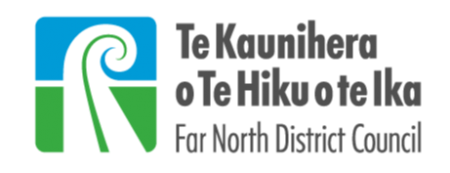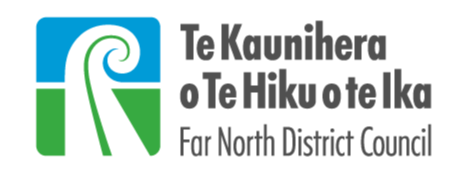Governance
Far North District Council came into being on 1 November 1989 as a result of the legislated amalgamation of the Bay of Islands County Council, Hokianga County Council, Whangaroa County Council, Mangonui County Council, Kaikohe Borough Council and the Kaitaia Borough Council. The Council is the northernmost in New Zealand.
Council's role
The District Council is responsible for establishing policies and strategies determining the overall direction of Council. These policies and strategies are implemented by the Chief Executive and Council staff. Learn more about our governance structure here. The purpose of local government in New Zealand is:
- To enable democratic decision-making and action by, and on behalf of communities.
- To promote the social, economic, environmental and cultural well-being of communities, in the present and for the future.
Council members
The Far North District Council currently comprises of a Mayor and ten Councillors who represent the four wards within the District. The Mayor is independently elected over the whole district, along with our four Councillors elected to the Ngā Tai o Tokerau Ward. General Ward Councillors are elected for three general electoral areas (wards) – Te Hiku, Kaikohe-Hokianga and Bay of Islands-Whangaroa. The District is divided into wards and then each ward is made up of various Community Board subdivisions. More information about their roles and appointments will be included in the Governance Statement due to be published in March. If you want to know who our elected members are, and how you can contact them there are profiles available at Mayor and Councillors or Community Boards
Local Governance Statement
The Local Governance Statement is a collection of information about the processes through which Council engages with the residents of Far North District, how the Council makes decisions, and how citizens can influence these processes.
The Local Governance Statement provides the public with information on ways to engage in local democratic processes. The Local Governance Statement includes the following broad categories of information:
- functions, responsibilities and activities of the local authority
- electoral arrangements
- governance structures and processes
- the way elected members make decisions and relate to each other and to the management of the local authority
- key policies of the local authority.
Code of Conduct
Council adopted their current Code of Conduct for elected members on 27 October 2022. The Local Government Act requires all local authorities to adopt a code of conduct that, among other things, sets out their expectations about the manner in which members may conduct themselves while acting in their capacity as members, including behaviour toward one another, staff, and the public.
Community boards are not required to adopt a Code of Conduct. However, the Bay of Islands-Whangaroa Community Board have chosen to adopt this Code of Conduct
A Code of Conduct for employees, contractors and consultants was updated in February 2017.
External appointments and portfolios
In addition to its formal committees, the Far North District Council has a number of additional forums which deal with specific issues, and also makes appointments to various external forums to ensure District input. A full list of external bodies elected members are appointed to can be accessed here .
Briefing Papers
Formal Meetings are the mechanism to make decisions as governors for the district. In addition, members receive information from time to time to keep them up to date on matters of interest. Previously, some of these would have been published on a formal meeting agenda to provide public transparency as an information report. This term, information will be published here as a briefing paper instead. Some briefing documents will lead into a decision-making paper, while others simply provide information for reference. Some briefing papers will be withheld in accordance with Local Government Official Information and Meetings Act under the public exclusion rules.
Community Boards
There are three community boards - Te Hiku, Kaikohe-Hokianga, and Bay of Islands-Whangaroa - whose 19 members are elected from the three general wards, which are divided into 12 subdivisions.
The Local Government Act 2002 states the role of a community board is to:-
- Represent, and act as an advocate for, the interests of its community;
- Consider and report on all matters referred to it by the territorial authority, or any matter of interest or concern to the community board;
- Maintain an overview of services provided by the territorial authority within the community;
- Prepare an annual submission to the territorial authority for expenditure within the community;
- Communicate with community organisations and special interest groups within the community;
- Undertake any other responsibilities that are delegated to it by the territorial authority
Standing Orders
Standing orders set out the rules for the conduct of council and community board meetings. Their purpose is to support these bodies to make decisions in a transparent, inclusive and lawful manner.
- Far North District Council Standing Orders were adopted on 21 September 2023
- Kaikohe-Hokianga Community Board Standing Orders were adopted on 06 November 2019
- Bay of Islands-Whangaroa Community Board Standing Orders were adopted on 04 November 2019 and noted at the 4 November 2022 meetings
- Te Hiku Community Board Standing Orders were adopted on 05 November 2019 and noted at 5 November 2022 meetings
Remuneration
Elected members' pay is set by the Remuneration Authority each year. You can read the Remuneration Authority's determination here. Council Elected Member Allowance and Reimbursement policy outlines the rules on the claiming of expenses by elected members and the resources that will be available to them during their term of office.
Council may appoint a person who is not an elected member to a committee or subcommittee. Allowances paid are outlined in the Appointed Members Allowances Policy
Elected Member Expenses
Council Committees and Membership
Te Huia - Executive Review Committee
At the 23 November 2022 Council meeting the Executive Review Committee was adopted and name updated at the 15 December Council meeting.
A Huia is a bird of the highest esteem in Te Ao Māori and greatly revered. It is synonymous with great leaders and leadership.
Te Miromiro - Assurance, Risk and Finance Committee
Established at 15 December 2022 Council meeting.
A Miromiro (Tomtit) has a keen eye for detail. He kanohi hōmiromiro - to have the eyes of a Tomtit is a metaphor used to ensure attention to detail.
Te Kuaka - Te Ao Māori Committee
Established at 15 December 2022 Council meeting.
The background to this name comes from the narrative of the Kuaka (Godwit) being a harbinger of resilience due to its ability to travel long distances to reach its final destination (me manawa Kuaka - have the heart of a Godwit).
Kuaka also travel in huge flocks - strength in unity to achieve purpose.
Te Pīpīwharauroa - External Members Appointment Committee
Established at 15 December 2022 Council meeting.
In Te Ao Māori a Pīpīwharauroa (Shining Cuckoo) is recognised as the “bearer of news”. Furthermore, as is the nature of the Cuckoo, it lays its egg in the nests of other birds to be raised and nurtured, a metaphor for our Council’s Committees.
Te Koekoeā - Appointment to Council Organisations Committee
A Koekoeā (long tailed cuckoo) is another bird that lays its eggs in the nests of others. Our committee is made to appoint members to council organisations, and a Koekoeā is incredibly selective in this task, another metaphor for the function of this committee.
Te Koukou - Transport and Infrastructure Committee
A koukou (owl) is associated with travellers as well as carrying messages.
| Kōwhai - Deputy Mayor Kelly Stratford (Chairperson) |
| Kahika – Mayor Moko Tepania (Deputy Chairperson) |
| Councillor Hilda Halkyard-Harawira |
| Councillor Steve McNally |
| Councillor Penetaui Kleskovic |
| Councillor Tāmati Rākena |
| Councillor Felicity Foy |
| Councillor Babe Kapa |
| Councillor John Vujcich |
| Councillor Mate Radich |
| Graeme McGlinn (Chairperson) |
| Councillor John Vujcich (Deputy Chairperson) |
| Kahika - Mayor Moko Tepania |
| Kōwhai - Deputy Mayor Kelly Stratford |
| Councillor Ann Court |
| Councillor Penetaui Kleskovic |
| Councillor Steve McNally |
| Harry Burkhardt (Chairperson) |
| Hilda Halkyard-Harawira (Deputy Chairperson |
| Kahika - Mayor Moko Tepania |
| Kōwhai – Deputy Mayor Kelly Stratford |
| Councillor Ann Court |
| Councillor Felicity Foy |
| Councillor Babe Kapa |
| Councillor Penetaui Kleskovic |
| Councillor Steve McNally |
| Councillor Mate Radich |
| Councillor Tāmati Rākena |
| Councillor John Vujcich |
| Te Kahu o Taonui Representatives |
| Kahika – Mayor Moko Tepania (Chairperson) |
Councillor Steve McNally (Deputy Chairperson) |
| Kōwhai - Deputy Mayor Kelly Stratford |
| Councillor Felicity Foy |
| Councillor Ann Court |
| Councillor Hilda Halkyard-Harawira |
| Councillor Babe Kapa |
| Councillor Penetaui Kleskovic |
| Councillor Tāmati Rākena |
| Councillor Mate Radich |
| Councillor John Vujcich |
| Councillor John Vujcich (Chairperson) |
| Councillor Penetaui Kleskovic |
| Councillor Steve McNally |
| Councillor Steve McNally |
| Councillor Hilda Halkyard-Harawira |
Elected member - Register of Interests 2023
Elected members are required identify pecuniary or other conflict of interests and are required stand aside from decision-making when a conflict arises between their role as a Member of the Council and any private or other external interest they might have.
Petition the Council
Any person or organisation can present a petition to the Council, a Committee, or a Community Board. Petitions must contain at least 20 signatures and the request must consist of fewer than 150 words (not including signatures).
The petition can be received either in hard copy or electronically and should be delivered to the Governance Support Team. Your submission should be addressed to the Chief Executive. You will be provided with the opportunity to speak to your petition at a public meeting and elected members may ask you questions. After the petition is considered, the Chief Executive will notify the petitioner of the outcome.
For more information or to present your petition, contact the Democracy Services Team via email governance@fndc.govt.nz or call 09 401 5231.

